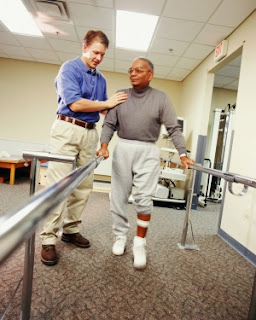Walking:
or upright bipedal locomotion, is a critical fundamental locomotion skill as
the hands become free to explore, and consists of two phases. These two
phases are the swing phase and the support phase, and makes up the gait cycle.
Balance consists of two types, static and dynamic, that are essential to the
development of walking. Static balance is the ability to maintain posture in a
stationary position. Dynamic balance is balance obtained when the body is
in motion. At the beginning of walking, the infant is said to have a dynamic base,
which is where the child's feet are widened to increase balance. Children
also have a high guard arm position which helps protect them if they fall and
increases their balance. In terms of the infants feet, they tend to have
a flat footed step where the toes are pointed laterally or away from the body’s
center line. As the child gains neuromuscular control and the muscles become
more developed, they walk with improved balance, arms lower to side and work in
opposition to the legs, and the toes point in a more forward direction.
 |
| Figure 1. Toes pointed outward from body |
Running:
is
sometimes referred to as the extension of walking, and consists of an alternate
support phase and an airborne phase. The support phase consists of the absorption
of impact by the leg, body support, and maintaining forward motion. The flight phase
is where the body is projected through space by the thrust leg. Lastly, a
recovery phase is achieved where the leg that thrust the body into the air
(support leg) enters a period of recovery. As with walking and jumping, balance
and muscular strength are needed for the development of running.
 |
| Figure 2. Body is projected through space by the thrust leg |
Jumping:
is different from running, in that the body is airborne from force generated by
one or both legs, and the body can also land on one or both feet. Jumping can
be accomplished in several ways, including hopping and leaping. To
differentiate between the two, the landing of a hop will be on the same leg it
propelled with while a leap would result in landing on the non-propelling
leg. Two other types of jumping are the
vertical and horizontal jump. A vertical jump is when the body is going upward
while horizontal is upward, as well as outward. Jumping usually occurs in 4 different phases
which include the preparatory phase, takeoff, flight, and landing. Two
constraints in jumping include the strength of the individual and their ability
to get their body in the air, as well as the muscular power.
 |
| Figure 3.Child displaying a vertical jump |
The
gallop, slide, and skip: These more complex motor patterns
do not appear until after the development of the single motor skills. Gallop is
the first to develop after running, and involves a forward step followed by the
trailing foot. The lead foot is initially with the dominant leg, but leading
with the non-preferred leg appear several years later.
The
slide is very similar to the gallop, except instead of moving forward, one
moves horizontally in sliding. This skill is hard to grasp for children because
the child must face a different direction from the intended movement. Finally,
skipping is the most difficult, because it involves an uneven rhythmical
pattern. Both step and hop must be accomplished on the same foot before
alternating.
 |
| Figure 4. Child skipping |
Applied
Section: The fundamental locomotion skills described have
some application to our future in the medical field. As healthcare providers,
it is critical to understand the normal from the abnormal in order for proper
diagnosis to be accomplished. Furthermore, girls typically develop the
fundamental locomotion skills earlier than boys, so if a concerned mother came
in with her boy not skipping at six to seven years of age, we could inform her
that it is a normal occurrence. We could also prescribe her with the proper
exercise module to increase her child’s locomotion skills.
It is also essential to understand the process of
how each fundamental motor skill is obtained. Working as a future
physical therapist, it would be essential to understand the sequence of motor
movement in a fundamental skill to teach a patient who may have a
disability how to walk again. Another example would be trying to help an
athlete who has had knee surgery to rehabilitate his/her knee in the most
efficient manner, so he/she could return to play as quickly as possible.
 |
| Figure 5. Learning how to walk |
No comments:
Post a Comment